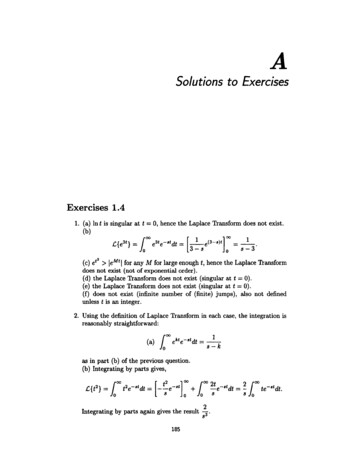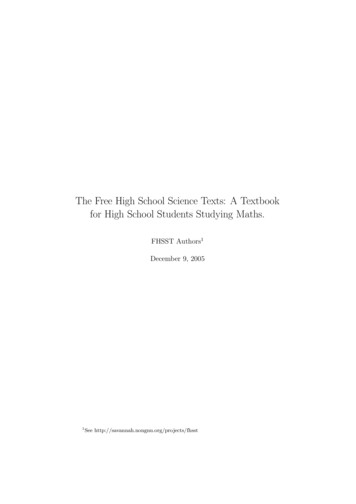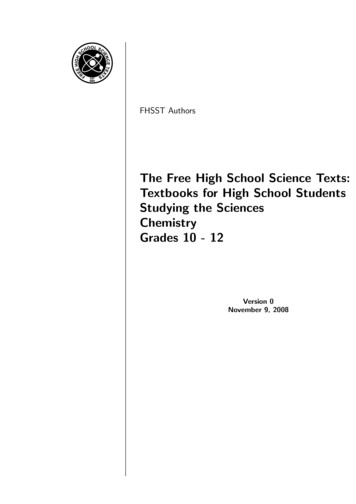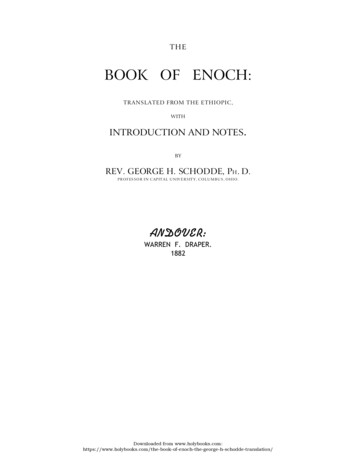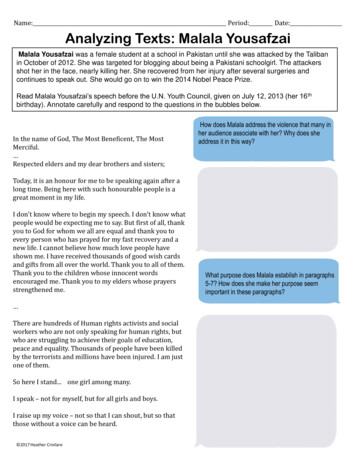
Transcription
Springer Texts in StatisticsAdvisors:George CasellaStephen FienbergIngram Olkin
Springer Texts in StatisticsAlfred: Elements of Statistics for the Life and Social SciencesBerger: An Introduction to Probability and Stochastic ProcessesBilodeau and Brenner: Theory of Multivariate StatisticsBlom: Probability and Statistics: Theory and ApplicationsBrockwell and Davis: Introduction to Times Series and Forecasting, SecondEditionChow and Teicher: Probability Theory: Independence, Interchangeability,Martingales, Third EditionChristensen: Advanced Linear Modeling: Multivariate, Time Series, andSpatial Data—Nonparametric Regression and Response SurfaceMaximization, Second EditionChristensen: Log-Linear Models and Logistic Regression, Second EditionChristensen: Plane Answers to Complex Questions: The Theory of LinearModels, Third EditionCreighton: A First Course in Probability Models and Statistical InferenceDavis: Statistical Methods for the Analysis of Repeated MeasurementsDean and Voss: Design and Analysis of Experimentsdu Toit, Steyn, and Stumpf: Graphical Exploratory Data AnalysisDurrett: Essentials of Stochastic ProcessesEdwards: Introduction to Graphical Modelling, Second EditionFinkelstein and Levin: Statistics for LawyersFlury: A First Course in Multivariate StatisticsJobson: Applied Multivariate Data Analysis, Volume I: Regression andExperimental DesignJobson: Applied Multivariate Data Analysis, Volume II: Categorical andMultivariate MethodsKalbfleisch: Probability and Statistical Inference, Volume I: Probability,Second EditionKalbfleisch: Probability and Statistical Inference, Volume II: StatisticalInference, Second EditionKarr: ProbabilityKeyfitz: Applied Mathematical Demography, Second EditionKiefer: Introduction to Statistical InferenceKokoska and Nevison: Statistical Tables and FormulaeKulkarni: Modeling, Analysis, Design, and Control of Stochastic SystemsLange: Applied ProbabilityLehmann: Elements of Large-Sample TheoryLehmann: Testing Statistical Hypotheses, Second EditionLehmann and Casella: Theory of Point Estimation, Second EditionLindman: Analysis of Variance in Experimental DesignLindsey: Applying Generalized Linear Models(continued after index)
Larry WassermanAll of NonparametricStatisticsWith 52 Illustrations
Larry WassermanDepartment of StatisticsCarnegie Mellon UniversityPittsburgh, PA 15213-3890USAlarry@stat.cmu.eduEditorial BoardGeorge CasellaStephen FienbergIngram OlkinDepartment of StatisticsUniversity of FloridaGainesville, FL 32611-8545USADepartment of StatisticsCarnegie Mellon UniversityPittsburgh, PA 15213-3890USADepartment of StatisticsStanford UniversityStanford, CA 94305USALibrary of Congress Control Number: 2005925603ISBN-10: 0-387-25145-6ISBN-13: 978-0387-25145-5Printed on acid-free paper. 2006 Springer Science Business Media, Inc.All rights reserved. This work may not be translated or copied in whole or in part without the written permission of the publisher (Springer Science Business Media, Inc., 233 Spring Street, NewYork, NY 10013, USA), except for brief excerpts in connection with reviews or scholarly analysis.Use in connection with any form of information storage and retrieval, electronic adaptation, computer software, or by similar or dissimilar methodology now known or hereafter developed is forbidden.The use in this publication of trade names, trademarks, service marks, and similar terms, even if theyare not identified as such, is not to be taken as an expression of opinion as to whether or not theyare subject to proprietary rights.Printed in the United States of America.9 8 7 6 5 4 3 2 1springeronline.com(MVY)
To Isa
PrefaceThere are many books on various aspects of nonparametric inference suchas density estimation, nonparametric regression, bootstrapping, and waveletsmethods. But it is hard to find all these topics covered in one place. The goalof this text is to provide readers with a single book where they can find abrief account of many of the modern topics in nonparametric inference.The book is aimed at master’s-level or Ph.D.-level statistics and computerscience students. It is also suitable for researchers in statistics, machine learning and data mining who want to get up to speed quickly on modern nonparametric methods. My goal is to quickly acquaint the reader with the basicconcepts in many areas rather than tackling any one topic in great detail. Inthe interest of covering a wide range of topics, while keeping the book short,I have opted to omit most proofs. Bibliographic remarks point the reader toreferences that contain further details. Of course, I have had to choose topicsto include and to omit, the title notwithstanding. For the most part, I decidedto omit topics that are too big to cover in one chapter. For example, I do notcover classification or nonparametric Bayesian inference.The book developed from my lecture notes for a half-semester (20 hours)course populated mainly by master’s-level students. For Ph.D.-level students,the instructor may want to cover some of the material in more depth andrequire the students to fill in proofs of some of the theorems. Throughout, Ihave attempted to follow one basic principle: never give an estimator withoutgiving a confidence set.
viiiPrefaceThe book has a mixture of methods and theory. The material is meantto complement more method-oriented texts such as Hastie et al. (2001) andRuppert et al. (2003).After the Introduction in Chapter 1, Chapters 2 and 3 cover topics related tothe empirical cdf such as the nonparametric delta method and the bootstrap.Chapters 4 to 6 cover basic smoothing methods. Chapters 7 to 9 have a highertheoretical content and are more demanding. The theory in Chapter 7 lays thefoundation for the orthogonal function methods in Chapters 8 and 9. Chapter10 surveys some of the omitted topics.I assume that the reader has had a course in mathematical statistics suchas Casella and Berger (2002) or Wasserman (2004). In particular, I assumethat the following concepts are familiar to the reader: distribution functions,convergence in probability, convergence in distribution, almost sure convergence, likelihood functions, maximum likelihood, confidence intervals, thedelta method, bias, mean squared error, and Bayes estimators. These background concepts are reviewed briefly in Chapter 1.Data sets and code can be found at:www.stat.cmu.edu/ larry/all-of-nonparI need to make some disclaimers. First, the topics in this book fall underthe rubric of “modern nonparametrics.” The omission of traditional methodssuch as rank tests and so on is not intended to belittle their importance. Second, I make heavy use of large-sample methods. This is partly because I thinkthat statistics is, largely, most successful and useful in large-sample situations,and partly because it is often easier to construct large-sample, nonparametric methods. The reader should be aware that large-sample methods can, ofcourse, go awry when used without appropriate caution.I would like to thank the following people for providing feedback and suggestions: Larry Brown, Ed George, John Lafferty, Feng Liang, Catherine Loader,Jiayang Sun, and Rob Tibshirani. Special thanks to some readers who provided very detailed comments: Taeryon Choi, Nils Hjort, Woncheol Jang,Chris Jones, Javier Rojo, David Scott, and one anonymous reader. Thanksalso go to my colleague Chris Genovese for lots of advice and for writing theLATEX macros for the layout of the book. I am indebted to John Kimmel,who has been supportive and helpful and did not rebel against the crazy title.Finally, thanks to my wife Isabella Verdinelli for suggestions that improvedthe book and for her love and support.Larry WassermanPittsburgh, PennsylvaniaJuly 2005
Contents1 Introduction1.1 What Is Nonparametric Inference?1.2 Notation and Background . . . . .1.3 Confidence Sets . . . . . . . . . . .1.4 Useful Inequalities . . . . . . . . .1.5 Bibliographic Remarks . . . . . . .1.6 Exercises . . . . . . . . . . . . . .1. 1. 2. 5. 8. 10. 102 Estimating the cdf andStatistical Functionals2.1 The cdf . . . . . . . . . . . . . . .2.2 Estimating Statistical Functionals2.3 Influence Functions . . . . . . . . .2.4 Empirical Probability Distributions2.5 Bibliographic Remarks . . . . . . .2.6 Appendix . . . . . . . . . . . . . .2.7 Exercises . . . . . . . . . . . . . .13131518212323243 The3.13.23.33.43.5.272730313235Bootstrap and the JackknifeThe Jackknife . . . . . . . . . . .The Bootstrap . . . . . . . . . .Parametric Bootstrap . . . . . .Bootstrap Confidence Intervals .Some Theory . . . . . . . . . . .
xContents3.63.73.8Bibliographic Remarks . . . . . . . . . . . . . . . . . . . . . . . 37Appendix . . . . . . . . . . . . . . . . . . . . . . . . . . . . . . 37Exercises . . . . . . . . . . . . . . . . . . . . . . . . . . . . . . 394 Smoothing: General Concepts4.1 The Bias–Variance Tradeoff .4.2 Kernels . . . . . . . . . . . .4.3 Which Loss Function? . . . .4.4 Confidence Sets . . . . . . . .4.5 The Curse of Dimensionality4.6 Bibliographic Remarks . . . .4.7 Exercises . . . . . . . . . . .43505557575859595 Nonparametric Regression5.1 Review of Linear and Logistic Regression . . . .5.2 Linear Smoothers . . . . . . . . . . . . . . . . . .5.3 Choosing the Smoothing Parameter . . . . . . .5.4 Local Regression . . . . . . . . . . . . . . . . . .5.5 Penalized Regression, Regularization and Splines5.6 Variance Estimation . . . . . . . . . . . . . . . .5.7 Confidence Bands . . . . . . . . . . . . . . . . . .5.8 Average Coverage . . . . . . . . . . . . . . . . . .5.9 Summary of Linear Smoothing . . . . . . . . . .5.10 Local Likelihood and Exponential Families . . . .5.11 Scale-Space Smoothing . . . . . . . . . . . . . . .5.12 Multiple Regression . . . . . . . . . . . . . . . .5.13 Other Issues . . . . . . . . . . . . . . . . . . . . .5.14 Bibliographic Remarks . . . . . . . . . . . . . . .5.15 Appendix . . . . . . . . . . . . . . . . . . . . . .5.16 Exercises . . . . . . . . . . . . . . . . . . . . . .6163666871818589949596991001111191191206 Density Estimation6.1 Cross-Validation . . . . . . . . . . . . . . . . .6.2 Histograms . . . . . . . . . . . . . . . . . . . .6.3 Kernel Density Estimation . . . . . . . . . . . .6.4 Local Polynomials . . . . . . . . . . . . . . . .6.5 Multivariate Problems . . . . . . . . . . . . . .6.6 Converting Density Estimation Into Regression6.7 Bibliographic Remarks . . . . . . . . . . . . . .6.8 Appendix . . . . . . . . . . . . . . . . . . . . .6.9 Exercises . . . . . . . . . . . . . . . . . . . . .125126127131137138139140140142.7 Normal Means and Minimax Theory1457.1 The Normal Means Model . . . . . . . . . . . . . . . . . . . . . 1457.2 Function Spaces . . . . . . . . . . . . . . . . . . . . . . . . . . . 147
onnection to Regression and Density EstimationStein’s Unbiased Risk Estimator (sure) . . . . . .Minimax Risk and Pinsker’s Theorem . . . . . . .Linear Shrinkage and the James–Stein Estimator .Adaptive Estimation Over Sobolev Spaces . . . . .Confidence Sets . . . . . . . . . . . . . . . . . . . .Optimality of Confidence Sets . . . . . . . . . . . .Random Radius Bands? . . . . . . . . . . . . . . .Penalization, Oracles and Sparsity . . . . . . . . .Bibliographic Remarks . . . . . . . . . . . . . . . .Appendix . . . . . . . . . . . . . . . . . . . . . . .Exercises . . . . . . . . . . . . . . . . . . . . . . .1491501531551581591661701711721731808 Nonparametric Inference Using Orthogonal Functions8.1 Introduction . . . . . . . . . . . . . . . . . . . . . . . . .8.2 Nonparametric Regression . . . . . . . . . . . . . . . . .8.3 Irregular Designs . . . . . . . . . . . . . . . . . . . . . .8.4 Density Estimation . . . . . . . . . . . . . . . . . . . . .8.5 Comparison of Methods . . . . . . . . . . . . . . . . . .8.6 Tensor Product Models . . . . . . . . . . . . . . . . . .8.7 Bibliographic Remarks . . . . . . . . . . . . . . . . . . .8.8 Exercises . . . . . . . . . . . . . . . . . . . . . . . . . .1831831831901921931931941949 Wavelets and Other Adaptive Methods9.1 Haar Wavelets . . . . . . . . . . . . . . . . . . . .9.2 Constructing Wavelets . . . . . . . . . . . . . . . .9.3 Wavelet Regression . . . . . . . . . . . . . . . . . .9.4 Wavelet Thresholding . . . . . . . . . . . . . . . .9.5 Besov Spaces . . . . . . . . . . . . . . . . . . . . .9.6 Confidence Sets . . . . . . . . . . . . . . . . . . . .9.7 Boundary Corrections and Unequally Spaced Data9.8 Overcomplete Dictionaries . . . . . . . . . . . . . .9.9 Other Adaptive Methods . . . . . . . . . . . . . .9.10 Do Adaptive Methods Work? . . . . . . . . . . . .9.11 Bibliographic Remarks . . . . . . . . . . . . . . . .9.12 Appendix . . . . . . . . . . . . . . . . . . . . . . .9.13 Exercises . . . . . . . . . . . . . . . . . . . . . . .19719920320620821121421521521622022122122310 Other Topics10.1 Measurement Error . . . .10.2 Inverse Problems . . . . .10.3 Nonparametric Bayes . . .10.4 Semiparametric Inference10.5 Correlated Errors . . . . .10.6 Classification . . . . . . .227227233235235236236.
Springer Texts in Statistics Alfred: Elements of Statistics for the Life and Social Sciences Berger: An Introduction to Probability and Stochastic Processes Bilodeau and Brenner:Theory of Multivariate Statistics Blom: Probability and Statistics: Theory and Applications Brockwell and Davis:Introduction to Times Series and Forecasting, Second Edition Chow and Teicher:Probability Theory .

